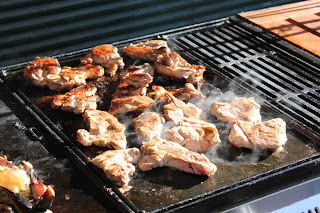My wonderful husband, Ben, planned our trip to KI so that we would arrive on a Saturday. This was so that we could attend the Farmer's Market on Sunday at Penneshaw (find info here on Penneshaw markets ) to support the local economy by purchasing locally grown food, and handmade items. Because we were visiting off-season, that is, not in the school holidays, the pickings were a little slim, but still very worthwhile.
We went to the Community Market first - handmade crafts and second hand things like old garden tools, and of course lots of toys and books. It was relaxing wandering around looking at all the creative output of different people. And THEN - I saw it. The last stall in the line. WOOL. Lots of wool. All the colours of the rainbow. Artfully displayed in baskets arranged in a semi-circle on the ground, beckoning me in. Hanks and hanks of it. I could tell by the uneven-ness it was hand spun and also hand-dyed by the look of it. OH YEAH.
I made a quick left turn and zoomed in to the centre point of the semi-circle and feasted my eyes on what was before me. I vaguely heard a voice behind me that sounded like my wonderful Ben ("Remember, Kate, we DIDN'T bring the trailer, OK........). Trailer, schmailer. I need wool, and I need it N.O.W.
I settled on one hand of pinky/red (fuschia, one might say) and one hand of lemon yellow for my good friend Liz, a knitting and sewing powerhouse. The person who took my money for the wool told me that it was the best wool to be had on the island (in his un-biased opinion, I'm sure), from Leicester sheep.
When we returned to our accommodation, I untied my fuchsia hank with glee, and after seeking a volunteer to hold the hank for me, wound the fuschia into 4 balls. I suspected it wouldn't be enough to make gloves for both Nicole and I, but would probably be enough to make "armies" which cover the wrist and palm. Armies will be great for next winter, as wearing gloves is fine when you are not driving, writing, typing, cooking, or reading a book, or doing anything else work-wise about the place. Unfortunately I had only brought crochet hooks with me, and not knitting needles (what was I thinking!) so had to content myself with crocheting the wool for a bit just for the pleasure of feeling it pass between my fingers and across the palms of my hands. Aaaaaaaaahhhhhhh. Wool. I admit it. I'm a yarn snob. Natural fibres for me.
 |
| Armies for Nicole completed |
 |
| Armies for Kate in progress |
DID YOU KNOW - you may not bring potatoes to KI, or soil that has had potatoes grown in it? To keep diseases out off the island. Same applies to bees or 2nd hand honey making equipment, or honey itself.
After visiting the Penneshaw Farmer's market, we had a dinner made from ENTIRELY local produce - Marron, spread with garlic butter and lightly bbqd, lamb chops (grown locally, low stress lamb), mashed potatoes, with broccolli.
MONDAY - we visited Clifford's honey farm and bought the mandatory honey icecream, as well as some other honey-related merchandise. The Ligurian Bee was sent to KI from Liguria in Italy in the 1800's to establish a honey bee colony. The colonies on KI remain the only pure Ligurian colony in the world.
 |
| Low stress lamb |
 |
| Marron with garlic butter |
We also visited the Island Pure Sheep dairy, and watched the sheep being milked. Sheep produce about 1 litre of milk, twice a day. There is no distinct cream in sheep's milk, so the milk is described as being naturally homogenized, so all the products are creamy in texture. We tasted all the cheeses and yoghurts, and bought some for later eating.
TUESDAY - rest day. Washing clothes. Read books, had naps, did some crochet. Took turns taking the kids to the playground (since kids don't seem to know the meaning of the word "rest").
 |
| View north from the Cottage |
 |
| Keith on the dashers while Ben supervises |
 |
| Nicole on the go-through tunnels |
WEDNESDAY - a big driving day! We drove from American River to the Raptor Domain on the south coast. We all voted the Raptor Domain birds of prey show as the best thing we did on our visit to Kangaroo Island.
 |
| Ben with Kookaburra |
The interactive show was captivating, and you could pre-order lunch before the birds of Prey show, eat it during the lunch break, and then stay for the Reptiles show afterwards. We didn't, as we were on a schedule and hadn't anticipated 2 separate shows being offered.
 |
| Nicole and Kate with Kookaburras |
 |
| Nicole with Owl |
 |
| Tilka the wedge-tailed eagle |
 |
| Kate with Kookaburra |















